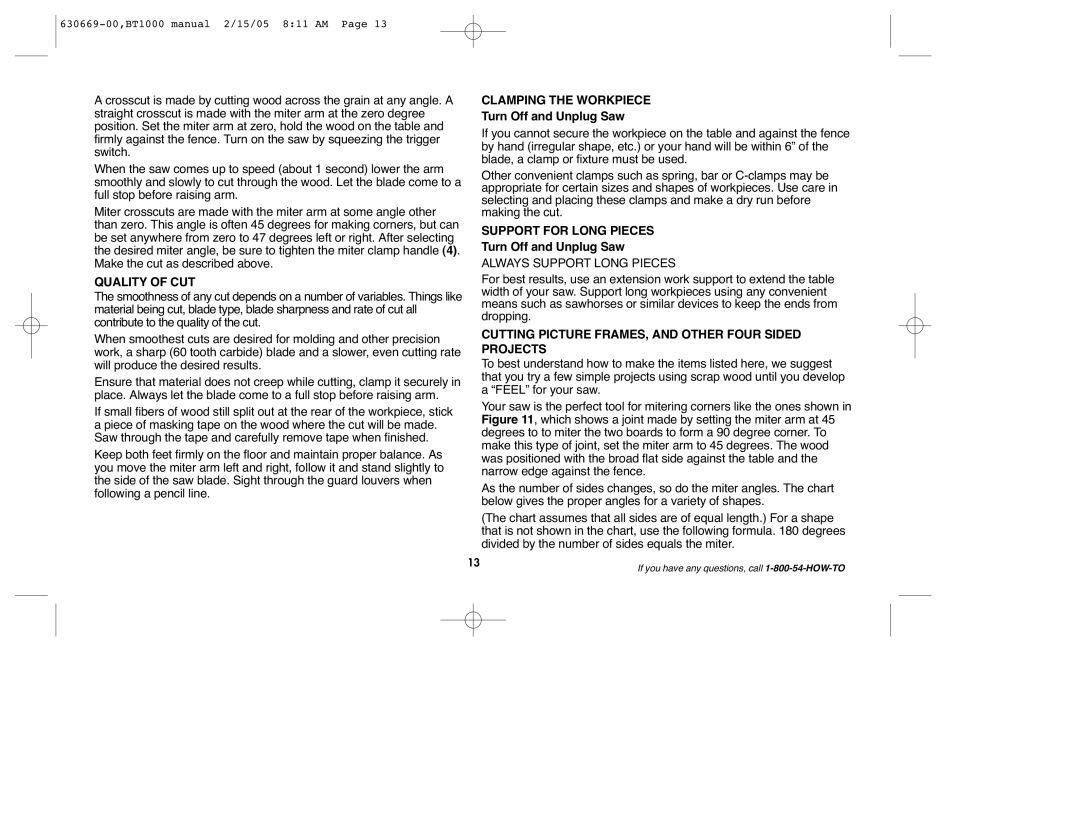
630669-00,BT1000 manual 2/15/05 8:11 AM Page 13
A crosscut is made by cutting wood across the grain at any angle. A straight crosscut is made with the miter arm at the zero degree position. Set the miter arm at zero, hold the wood on the table and firmly against the fence. Turn on the saw by squeezing the trigger switch.
When the saw comes up to speed (about 1 second) lower the arm smoothly and slowly to cut through the wood. Let the blade come to a full stop before raising arm.
Miter crosscuts are made with the miter arm at some angle other than zero. This angle is often 45 degrees for making corners, but can be set anywhere from zero to 47 degrees left or right. After selecting the desired miter angle, be sure to tighten the miter clamp handle (4). Make the cut as described above.
QUALITY OF CUT
The smoothness of any cut depends on a number of variables. Things like material being cut, blade type, blade sharpness and rate of cut all contribute to the quality of the cut.
When smoothest cuts are desired for molding and other precision work, a sharp (60 tooth carbide) blade and a slower, even cutting rate will produce the desired results.
Ensure that material does not creep while cutting, clamp it securely in place. Always let the blade come to a full stop before raising arm.
If small fibers of wood still split out at the rear of the workpiece, stick a piece of masking tape on the wood where the cut will be made. Saw through the tape and carefully remove tape when finished.
Keep both feet firmly on the floor and maintain proper balance. As you move the miter arm left and right, follow it and stand slightly to the side of the saw blade. Sight through the guard louvers when following a pencil line.
CLAMPING THE WORKPIECE
Turn Off and Unplug Saw
If you cannot secure the workpiece on the table and against the fence by hand (irregular shape, etc.) or your hand will be within 6” of the blade, a clamp or fixture must be used.
Other convenient clamps such as spring, bar or
SUPPORT FOR LONG PIECES
Turn Off and Unplug Saw
ALWAYS SUPPORT LONG PIECES
For best results, use an extension work support to extend the table width of your saw. Support long workpieces using any convenient means such as sawhorses or similar devices to keep the ends from dropping.
CUTTING PICTURE FRAMES, AND OTHER FOUR SIDED PROJECTS
To best understand how to make the items listed here, we suggest that you try a few simple projects using scrap wood until you develop a “FEEL” for your saw.
Your saw is the perfect tool for mitering corners like the ones shown in Figure 11, which shows a joint made by setting the miter arm at 45 degrees to to miter the two boards to form a 90 degree corner. To make this type of joint, set the miter arm to 45 degrees. The wood was positioned with the broad flat side against the table and the narrow edge against the fence.
As the number of sides changes, so do the miter angles. The chart below gives the proper angles for a variety of shapes.
(The chart assumes that all sides are of equal length.) For a shape that is not shown in the chart, use the following formula. 180 degrees divided by the number of sides equals the miter.
13 | If you have any questions, call |
|
